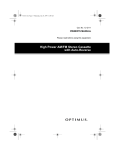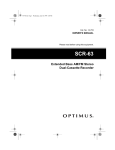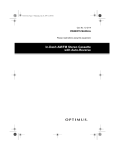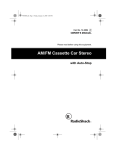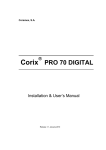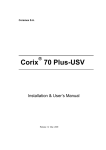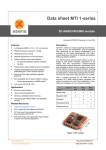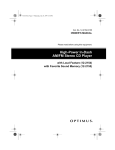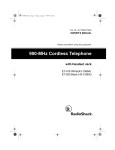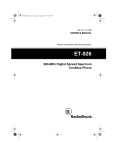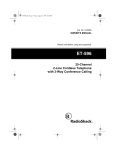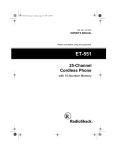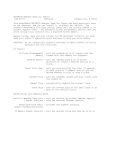Download Radio Shack AM/FM Auto Reverse Cassette Owner`s manual
Transcript
12-2113.fm Page 1 Wednesday, July 14, 1999 12:18 PM Cat. No. 12-2113 OWNER’S MANUAL Please read before using this equipment. High-Power In-Dash AM/FM Stereo Cassette with Auto-Reverse 12-2113.fm Page 2 Wednesday, July 14, 1999 12:18 PM FEATURES Your Optimus High-Power In-Dash AM/FM Stereo Cassette with Auto-Reverse has many practical, easy-to-use features, and you can install it in almost any vehicle. The tuner’s digital synthesized PLL (Phase-Locked Loop) circuitry gives you precise tuning and drift-free reception. The stereo’s anti-theft control panel lets you quickly remove it, making the stereo inoperative. The auto-reverse cassette deck, memory tuning, and seek and scan tuning all help make your stereo’s operation simple and quick so you can drive safely. Caution: Use common sense. Do not change your stereo’s settings in heavy traffic or during hazardous driving conditions. This stereo’s features include: Anti-Theft Control Panel — lets you quickly remove and store the stereo’s control panel in the supplied carry case. This discourages theft because the stereo cannot operate without the control panel. Auto-Reverse — continuously plays both sides of a cassette tape. Fast-Forward/Rewind — lets you quickly move the tape to the beginning or the end. Metal/CrO2 Tape Selector — takes advantage of the improved sound quality of metal or CrO2 tapes. Advanced FM Optimizer Circuitry — automatically adjusts the tuner’s high-frequency response and stereo separation to give you the best possible sound, regardless of the signal level. Automatic FM Tuning Adjustment — automatically changes FM reception on weak stations from stereo to mono, to improve reception of those stations. Lighted Liquid-Crystal Display with Clock — lets you easily see the clock/radio/cassette deck’s current functions. Band Button — lets you select the AM or FM band with the push of a button. Seek Tuning — searches forward to the next strong station in the selected band. © 1997 Tandy Corporation. All Rights Reserved. Optimus is a registered trademark used by Tandy Corporation. RadioShack is a trademark used by Tandy Corporation. 2 12-2113.fm Page 3 Wednesday, July 14, 1999 12:18 PM Automatic Seek Sensitivity — adjusts your stereo so the first time it searches a band, it stops only on strong local stations; the next time it searches, it also stops on weaker, distant stations. We recommend you record your stereo’s serial number here. The number is on the top of the stereo. Serial Number: ________________ High Power — provides 22 watts of total power to give you excellent audio response for all types of music. Digitally Synthesized Circuitry — gives you precise tuning and driftfree reception. Manual/Automatic Memory Programming — lets you manually or automatically store 18 FM and 12 AM stations into memory groups so you can quickly tune to those stations. Memory Scan Tuning — scans all stations in an AM or FM memory group, stopping for 5 seconds on each station. Display Color Selector — lets you change the display’s color to amber or green. Built-in Noise Suppression Choke — reduces the noise caused by your vehicle’s electrical system. 3 12-2113.fm Page 4 Wednesday, July 14, 1999 12:18 PM CONTENTS Installation ....................................................................................................... 5 Before You Begin the Installation ............................................................... 5 Preparing the Mounting Area ............................................................... 5 Routing Speaker Wires ........................................................................ 5 Removing the Shipping Screw............................................................. 5 Making the Connections ............................................................................. 6 Using an Adapter Harness................................................................... 7 Connecting Ground, Power, and Optional Components ...................... 7 Connecting Two Pairs of Speakers...................................................... 9 Connecting One Pair of Speakers ..................................................... 10 Connecting the Antenna ..................................................................... 11 Completing the Connections............................................................... 11 Testing the Connections .............................................................................11 Mounting the Stereo .................................................................................. 12 Removing the Stereo from the Dash ........................................................ 14 Using the Control Panel ............................................................................... 15 Installing the Control Panel ...................................................................... 15 Removing the Control Panel .................................................................... 15 Basic Operation ............................................................................................ Setting the Clock ...................................................................................... Changing the Display’s Color ................................................................... Adjusting the Controls .............................................................................. 16 16 16 17 Radio Operation ............................................................................................ 19 Playing the Radio ..................................................................................... 19 Memory Tuning.......................................................................................... 20 Manually Storing Stations .................................................................. 20 Automatically Storing Stations ........................................................... 20 Selecting a Stored Station ................................................................. 21 Scanning Stored Stations .................................................................. 21 Cassette Player Operation ........................................................................... 22 Playing a Cassette ................................................................................... 22 Fast-Forward and Rewind ........................................................................ 23 Care and Maintenance................................................................................... 24 The FCC Wants You to Know................................................................... 24 Cleaning the Tape-Handling Parts............................................................ 24 Restoring Tape Tension and Sound Quality ............................................. 25 Replacing a Fuse ...................................................................................... 25 Specifications................................................................................................ 27 4 12-2113.fm Page 5 Wednesday, July 14, 1999 12:18 PM INSTALLATION BEFORE YOU BEGIN THE INSTALLATION Before you install your stereo, read all the instructions in this owner’s manual. You should be able to answer all of these questions about your vehicle’s electrical and sound systems. • Which terminal in my vehicle’s fuse box is for accessories? • How do I connect a wire to the fuse box? • Which of the stereo’s wires is the power wire? • Which stereo wires are speaker outputs? Also, be aware that installation in your vehicle might require cutting or modifying your vehicle. • If the mounting area is too large, you might be able to mount the stereo with an in-dash installation kit, available at your local RadioShack store. Follow the installation kit’s instructions to mount the stereo. Routing Speaker Wires If you install speakers, avoid routing the speaker wires near moving parts or sharp edges. You can usually route wires along the wiring channel beneath the vehicle’s door facings by carefully removing the molding that holds the carpet in place. After you route the wires, replace the molding. Removing the Shipping Screw The shipping screw helps protect the stereo’s cassette player from being damaged during shipment. Preparing the Mounting Area Before you mount the stereo, make sure you have all the necessary materials. Then confirm that the stereo fits your vehicle’s mounting area. Caution: Be sure to avoid obstructions behind the mounting surface. Notes: Before you mount the stereo, use a Phillips screwdriver to remove the screw, spacer, and rubber washer from the top of the stereo. This allows you to remove the mounting sleeve from the stereo. Screw Spacer Rubber Washer • This stereo is a DIN-E size unit that requires a 2 1/16-inch (53 mm) high by 73/16-inch (182 mm) wide by 611/16-inch (170 mm) deep mounting area. 5 12-2113.fm Page 6 Wednesday, July 14, 1999 12:18 PM Note: Save the screw, spacer, and rubber washer in case you ever want to ship the stereo. You can secure them to the back of the stereo with a piece of tape. MAKING THE CONNECTIONS The supplied harness with the 14-pin connector includes all the lead wires you need to connect the stereo to ground, power, some optional components, and speakers. Important: Do not cut these wires. If you cut any wire, you cannot obtain a refund or exchange on this product. RadioShack will provide warranty service if you cut a wire and find the product is defective. You might need additional wire, depending on your individual auto sound system, to complete the connections. Your local RadioShack store carries a full line of wire and wire management accessories. 6 Cautions: • For added safety and to protect your stereo, disconnect the cable from your vehicle battery’s negative (–) terminal before you begin. • Be sure your speakers can handle 22 watts of power (11 watts per channel). Each speaker must have an impedance of at least 4 ohms. Your local RadioShack store carries a full line of speakers. • You must connect the GROUND (–), POWER LEAD (B+), and CLOCK MEMORY wires first, then make all other connections as described in the following sections before you plug the harness into the stereo. If you do not make the connections in the order shown, an incorrect connection could damage the stereo. • You must connect a separate wire to each speaker terminal as described in “Connecting Two Pairs of Speakers” on Page 9 and “Connecting One Pair of Speakers” on Page 10. Do not use a common wire or chassis ground for any speaker connection. 12-2113.fm Page 7 Wednesday, July 14, 1999 12:18 PM Note: The wiring harness has the following labels. Front Left Speaker Rear Left Speaker Connecting Ground, Power, and Optional Components Front Right Speaker Wire Harness Follow these steps to connect the harness to ground, primary and memory backup power, and optional components. Rear Right Speaker Black GROUND (–) Red POWER LEAD B+ (To Chassis Ground) (To ACC) ON Blue/White AMP REMOTE TURN (To Optional Equipment) Yellow “Connecting Ground, Power, and Optional Components” and “Connecting Two Pairs of Speakers” on Page 9 or “Connecting One Pair of Speakers” on Page 10. CLOCK MEMORY Black GROUND (–) Red POWER LEAD B+ (To Optional Equipment) Yellow If you are replacing an existing stereo, or if your vehicle has been factory-wired for autosound components, you can use an adapter harness to connect the power and speakers. RadioShack stores sell adapter harnesses for most vehicles. Follow the directions that come with the adapter harness to temporarily connect the power and speakers. After you connect the adapter harness to your vehicle, you can skip (To ACC) Blue/White AMP REMOTE TURN ON (To Battery+) Using an Adapter Harness (To Chassis Ground) CLOCK MEMORY (To Battery +) 1. Disconnect the cable from your vehicle battery’s negative (–) terminal. Vehicle Negative Battery Cable Battery 2. Connect the black ground wire to a chassis ground, such as a metal screw attached to a metal part of the vehicle’s frame. Be sure that the screw is not insulated from the chassis by a plastic part. 7 12-2113.fm Page 8 Wednesday, July 14, 1999 12:18 PM 3. Connect the red power wire (with in-line fuse holder) to a point in your vehicle’s fuse block that has power only when you turn the vehicle’s key to either the accessory (ACC) or START position. Harness with 14-pin Connector Red POWER LEAD B+ (To ACC or START) This connection turns on the stereo when you turn on the ignition or turn the key to ACC, and turns off the stereo when you turn off the ignition. This prevents your vehicle’s battery from being drained if you leave the stereo on when you turn off the ignition. 4. Connect the yellow power/memory wire (with in-line fuse holder) to your vehicle battery’s positive (+) terminal or to a point in your vehicle’s fuse block that provides a continuous source of 12 volts. 8 This connection provides power for the stereo’s components (such as the clock), and continuous power for the stereo’s memory when the ignition is turned off. 5. Connect the blue/white wire to any optional equipment, designed to run from a switched source, that you want the stereo to turn on and off (such as a booster or a power antenna). This wire does not provide power to the components. It simply turns them on or off. If you do not use this wire, secure it with a wire tie and do not let it touch metal. 12-2113.fm Page 9 Wednesday, July 14, 1999 12:18 PM Connecting Two Pairs of Speakers If you are using both front and rear speakers, follow these steps to connect the harness to the speakers. Left Right White Front White/Black Green Rear Green/Black Gray Gray/Black Front Violet Violet/Black Rear 1. Use a small screwdriver to move 2 ch/4 ch on the bottom of the stereo to 4 ch (four channel). 2. Connect the gray wire to the right front speaker’s positive terminal. This terminal is usually marked with a plus (+) sign or red mark. 3. Connect the gray/black wire to the right front speaker’s negative terminal. This terminal might be marked with a minus ( –) sign or it might not be marked at all. 4. Connect the white wire to the left front speaker’s positive terminal. 5. Connect the white/black wire to the left front speaker’s negative terminal. 9 12-2113.fm Page 10 Wednesday, July 14, 1999 12:18 PM 6. Connect the violet wire to the right rear speaker’s positive terminal. 7. Connect the violet/black wire to the right rear speaker’s negative terminal. 8. Connect the green wire to the left rear speaker’s positive terminal. 9. Connect the green/black wire to the left rear speaker’s negative terminal. Connecting One Pair of Speakers If you are using only one pair of speakers, follow these steps to connect the harness to the speakers. Left Right White White/Black Green Green/Black Gray Gray/Black Violet Violet/Black 1. Use a small screwdriver to move 2 ch/4 ch on the bottom of the stereo to 2 ch (two channel). 2. Connect the gray wire to the right speaker’s positive terminal. This terminal is usually marked with a plus (+) sign or red mark. 10 12-2113.fm Page 11 Wednesday, July 14, 1999 12:18 PM 3. Connect the violet/black wire to the right speaker’s negative terminal. This terminal might be marked with a minus (–) sign or it might not be marked at all. 4. Connect the white wire to the left speaker’s positive terminal. 5. Connect the green/black wire to the left speaker’s negative terminal. Connecting the Antenna 14-Pin Wiring Socket Harness with 14-Pin Connector Vehicle Negative Battery Cable Battery Connect the vehicle’s antenna cable to the stereo’s large black antenna connector. Antenna Connector Vehicle’s Antenna Back of Stereo Completing the Connections Make sure you have securely made all other connections, then plug the harness’ connector into the stereo’s 14-pin wiring socket. Then reconnect the cable to the vehicle battery’s negative terminal. TESTING THE CONNECTIONS Turn on your vehicle’s ignition and install your stereo’s control panel (see “Installing the Control Panel” on Page 15). The display should light and the currently set time (or 12:00) should appear on the display when you press POWER to turn on the stereo. If the stereo does not work, immediately disconnect the cable from your vehicle battery’s negative (–) terminal. Then recheck your connections. After you verify that the display lights, follow the instructions in “Mounting the Stereo” on Page 12. 11 12-2113.fm Page 12 Wednesday, July 14, 1999 12:18 PM MOUNTING THE STEREO Press the keys downward, and slide the sleeve off of the stereo. Once you verify that the stereo is connected properly, follow these steps to mount the stereo. 1. Disconnect the cable from the vehicle battery’s negative (–) terminal. Vehicle Negative Battery Cable 5. Remove the keys from the slots. 6. Put the sleeve into the dash, then secure it by bending out all the tabs with a screwdriver. Battery 2. Disconnect the wire harness and the antenna. Antenna Connector Vehicle’s Antenna Back of Stereo Wire Harness 3. Press REL on the right side of the control panel to remove it (see “Removing the Control Panel” on Page 15). 4. Insert both of the supplied keys into the slots at the bottom left and right sides of the stereo. 12 7. If your vehicle has an existing mounting hole in the dash, use pliers or a 5/16-inch box-end wrench to attach the supplied washer and the short end of the supplied mounting bolt to the back of the stereo. 12-2113.fm Page 13 Wednesday, July 14, 1999 12:18 PM Note: The other end of the mounting bolt is covered by a rubber mounting grommet. 8. Reconnect the wire harness and the antenna. 9. Slide the stereo into the sleeve until it locks into place. If you are securing the stereo in an existing mounting hole in the dash, push the mounting bolt (covered by the mounting grommet) through the existing mounting hole and make sure it is secure. Otherwise, you can use the supplied bolt and washer to attach one end of the supplied metal strap to the mounting bolt on the back of the stereo. If necessary, bend the metal strap to fit your vehicle’s mounting area. Then use the supplied sheet metal screw to attach the other end of the strap to a solid metal part of the vehicle under the dashboard. This strap also helps ensure proper electrical grounding of the stereo. Mounting Grommet Note: If the mounting bolt is too short to reach the mounting hole, remove the rubber mounting grommet and screw the supplied mounting bolt extender onto the mounting bolt. Then push the rubber grommet onto the mounting bolt. 10. Snap the plastic collar onto the front of the stereo. Mounting Bolt Extender 13 12-2113.fm Page 14 Wednesday, July 14, 1999 12:18 PM 11. Reconnect the cable to the vehicle battery’s negative (–) terminal. Vehicle Negative Battery Cable Or, remove the bolt holding the metal strap to the back of the stereo. 3. Press REL to remove the stereo’s control panel. 4. Snap the plastic collar off of the front of the stereo. Battery Note: You might need to reset the stereo’s clock after you reconnect the cable to the vehicle battery. REMOVING THE STEREO FROM THE DASH If you ever want to remove the stereo from the dash, follow these steps. 1. Disconnect the cable from the vehicle battery’s negative (–) terminal. Vehicle Negative Battery Cable 5. Insert both of the supplied keys into the slots at the bottom left and right sides of the stereo. Press the keys downward and slide the stereo out of the dash. 6. Remove the keys from the slots. 7. Disconnect the wire harness and the antenna. 8. Reconnect the cable to the vehicle battery’s negative (–) terminal. Battery 2. If you secured the stereo to an existing mounting hole under the dash, slide out the stereo to free the mounting bolt from the mounting hole. 14 Vehicle Negative Battery Cable Battery 12-2113.fm Page 15 Wednesday, July 14, 1999 12:18 PM USING THE CONTROL PANEL The stereo’s control panel must be in place for the stereo to operate. When you remove it, the stereo does not work. This is a simple, but effective security measure. REMOVING THE CONTROL PANEL 1. Press REL on the right corner of the control panel. Any stored stations remain in memory when the control panel is removed. INSTALLING THE CONTROL PANEL 1. Insert the left edge of the control panel into the left edge of the recess. The holes in the control panel interlock with the pins in the recess. REL 2. Grasp the control panel on the right side and pull it out to remove it. 3. Store the control panel in the supplied carry case. 2. Gently push the right edge of the control panel into the recess until you hear a click. 15 12-2113.fm Page 16 Wednesday, July 14, 1999 12:18 PM BASIC OPERATION SETTING THE CLOCK Note: You can set the clock only when the vehicle’s ignition is turned on or set to ACC. 1. While holding down F/C, repeatedly press TUNE until the stereo displays the correct hour. Hold down TUNE to rapidly advance the hours. 2. While holding down F/C, repeatedly press TUNE until the stereo displays the correct minute. Hold down TUNE to rapidly advance the minutes. 16 CHANGING THE DISPLAY’S COLOR The display’s backlight color can be green or amber. Hold down POWER for about 3 seconds to change the display’s color from amber to green (or vice versa). 12-2113.fm Page 17 Wednesday, July 14, 1999 12:18 PM ADJUSTING THE CONTROLS When you listen to your stereo, you can adjust the following controls to suit your listening preferences. AUTO REVERSE Mute Audio Loud — Repeatedly press to increase or decrease the volume. VOL: and and the volume level appears on the display (such as VOL:30). The volume level ranges from 0 to 40. Warning: To protect your hearing, do not listen at high volume levels. Slowly increase the volume to a comfortable listening level. The display automatically returns to the time display 5 seconds after you finish adjusting the sound. AUDIO — Repeatedly press until BAS , TRE, BAL, or FAD and the current level appear on the display, then repeatedly press or within 5 seconds to change the stereo’s bass, treble, balance, or fader settings. Notes: • When you adjust the balance toward the left speakers, L and the left balance level appear on the display (such as L 5). When you adjust the balance toward the right speakers, R and the right balance level appear on the display (such as R 3). • When you adjust the fader toward the front speakers, F and the front fader level appear on the display (such as F 5). When you adjust the fader toward the rear speakers, R and the rear fader level appear on the display (such as R 3). 17 12-2113.fm Page 18 Wednesday, July 14, 1999 12:18 PM • If BAS, TRE, BAL , or FAD and the number disappear before you press or , repeatedly press AUDIO until the setting you want reappears, then repeatedly press or to set it. MUTE — Press to temporarily si- lence the stereo. - - - - appears on the display. To restore the sound, press MUTE again. LOUD — Press to boost the high and low frequencies when listening at low volume levels. LOUD appears on the display. Press LOUD again to return to normal sound. 18 12-2113.fm Page 19 Wednesday, July 14, 1999 12:18 PM RADIO OPERATION PLAYING THE RADIO 1. Press POWER to turn on the stereo. Seek Tuning: Hold down SEEK or SEEK for about 1 second to tune to the next lower or higher station. AUTO REVERSE 2. Press BAND to select the AM or FM band. AM 1 or AM 2 appears on the display when an AM band is selected. FM 1, FM 2, or FM 3 appears on the display when an FM band is selected. AUTO REVERSE Note: If the stereo does not find a strong station when seeking, it searches the band again for weaker stations. 4. Press or to increase or decrease the volume as desired. Notes: Notes: • Each time you press BAND , the radio tunes to the last station selected in the band. • ST appears on the display when an FM signal is received in stereo. 3. Tune to the desired station in one of the following ways. • See “Adjusting the Controls” on Page 17 for information about changing the stereo’s other settings. • To temporarily display the frequency of the station currently playing, press F/C. The display shows the frequency for about 5 seconds, then returns to the clock display. AUTO R Manual Tuning: Repeatedly press TUNE or TUNE to tune down or up the selected band. 19 12-2113.fm Page 20 Wednesday, July 14, 1999 12:18 PM MEMORY TUNING You can manually store up to 12 AM and 18 FM stations in memory groups. Each memory group (AM 1, AM 2, FM 1, FM 2, and FM 3) holds up to six stations. You can also automatically store stations into a memory group. Manually Storing Stations 1. Repeatedly press BAND to select the desired memory group (AM 1 or AM 2 for AM, or FM 1, FM 2, or FM 3 for FM). 2. Tune to the station you want to store. 3. Hold down the desired memory location button until the frequency, ME , and band and memory group appear on the display. The volume momentarily mutes while the radio stores the station. Automatically Storing Stations 1. Repeatedly press BAND to select the band and memory group where you want to store stations. For example, to store the first group of AM stations into AM 1, press BAND until AM 1 appears. 2. Hold down AMS (automatic memory scan) for about 3 seconds. The stereo scans the selected band and stores the first six stations it finds (starting with the currently tuned frequency). AUTO REVERSE During the scan, the stereo only searches for strong stations, and LOC appears on the display. If the stereo does not find six strong stations, it scans again, searching for weaker stations, and LOC disappears from the display. The band and memory group, frequency, and ME appear on the display. Then, after the stereo stores six stations or scans the band twice, it tunes to the first stored station and begins to play. 20 12-2113.fm Page 21 Wednesday, July 14, 1999 12:18 PM 3. To stop searching for stations before it automatically stops, briefly press AMS. Note: If a station has a weak signal or interference, the stereo might not store it automatically. If this happens, you can manually store the station. Selecting a Stored Station To select a stored station, press BAND to select the correct memory group. Then briefly press the desired memory location button. (Do not hold down the memory location button. This erases the previously stored station and stores the currently tuned station into that location.) Scanning Stored Stations The stereo’s automatic memory scan (AMS) feature scans all stored stations in a memory group you select, pausing for 5 seconds at each stored station. 1. Press BAND until the stereo displays the memory group you want to scan. 2. To start automatic memory scan, briefly press AMS. The radio begins scanning the stored stations, and the current memory location number flashes. (Do not hold down AMS . This causes the radio to automatically seek and store six stations into the selected memory group). AUTO REVERSE Memory Location Buttons 3. To stop scanning when the stereo pauses at a station you want to listen to, briefly press AMS. Otherwise, the stereo continues to scan the memory group. 21 12-2113.fm Page 22 Wednesday, July 14, 1999 12:18 PM CASSETTE PLAYER OPERATION PLAYING A CASSETTE C aution: We reco mmen d u sin g C-60 or C-90 cassette tapes. Avoid using C-120 cassette tapes. They are very thin and can easily become tangled in the tape-handling parts. 3. If you are playing a metal or CrO2 (Type II) tape, press METAL/4 until MTL appears on the display. AUTO REVERSE Follow these steps to play a cassette tape. 1. Take up any slack by turning the cassette’s hub with your finger or a pencil. Avoid touching the tape. 4. Adjust the volume, bass, treble, balance, and fader levels as desired. Notes: • When the tape reaches the end of one side, the cassette player automatically changes the tape’s direction and plays the other side of the tape. Play continues until you press . 2. Insert the tape into the cassette compartment with its open edge to the right. The tape begins to play, and the direction indicator ( or ) appears on the display • During play, you can switch to the other side of the cassette by pressing and at the same time until the indicator on the display changes direction. 5. Press all the way in to stop the tape and eject it. AUTO REV 22 12-2113.fm Page 23 Wednesday, July 14, 1999 12:18 PM Caution: We recommend you press before you leave your vehicle, to release the tape from the tape-handling parts. This reduces the possibility of a tape being tangled or damaged. FAST-FORWARD AND REWIND To fast-forward or quickly rewind the current side, firmly hold down or . The tape quickly winds. Play resumes when the tape reaches the end of that side. To stop fast-forward or rewind, gently press and release the opposite button. Play continues. 23 12-2113.fm Page 24 Wednesday, July 14, 1999 12:18 PM CARE AND MAINTENANCE Your Optimus High-Power In-Dash AM/FM Stereo Cassette with Auto-Reverse is an example of superior design and craftsmanship. The following suggestions will help you care for the stereo so you can enjoy it for years. Keep the stereo dry. If it gets wet, wipe it dry immediately. Liquids might contain minerals that can corrode the electronic circuits. Handle the stereo gently and carefully. Dropping it can damage circuit boards and cases and can cause the stereo to work improperly. Keep the stereo away from dust and dirt, which can cause premature wear of parts. CLEANER 24 Wipe the stereo with a damp cloth occasionally to keep it looking new. Do not use harsh chemicals, cleaning solvents, or strong detergents to clean the stereo. Modifying or tampering with the stereo’s internal components can cause a malfunction and might invalidate your stereo’s warranty and void your FCC authorization to operate it. If your stereo is not performing as it should, take it to your local RadioShack store for assistance. THE FCC WANTS YOU TO KNOW Your stereo might cause TV or radio interference even when it is operating properly. To determine whether your stereo is causing the interference, turn off your stereo If the interference goes away, your stereo is causing it. Try to eliminate the interference by: • Moving your stereo away from the receiver • Contacting your local dioShack store for help Ra- CLEANING THE TAPEHANDLING PARTS Clean the tape head after about every 20 hours of playing time. Insert a special head-cleaning cassette (such as Cat. No. 44-1202), and follow the cleaning cassette’s directions to clean the tape head. 12-2113.fm Page 25 Wednesday, July 14, 1999 12:18 PM RESTORING TAPE TENSION AND SOUND QUALITY After you play a cassette tape a few times, the tape might become tightly wound on the reels. This can cause playback sound quality to deteriorate. To restore the sound quality, fastforward the tape from the beginning to the end of one side, then completely rewind it. Then loosen the tape reels by gently tapping each side of the cassette’s outer shell on a flat surface. 1. Disconnect the cable from the vehicle battery’s negative (–) terminal. Vehicle Negative Battery Cable Battery 2. To open a fuse holder, pull the latches apart until it opens. Then, to remove the fuse, gently pull one of the fuse holder’s wires up and pull the fuse off of both wire clips inside the fuse holder. Caution: Be careful not to damage the cassette when tapping it. Do not touch the exposed tape or allow any sharp objects near the cassette. REPLACING A FUSE If the clock resets or stored stations are lost when the ignition is off, you might need to replace the yellow continuous power wire’s fuse with a fuse such as Cat. No. 270-1003 (not supplied). If the stereo does not operate, you might need to replace the red power wire’s fuse with a fuse such as Cat. No. 270-1012 (the supplied spare fuse is one). Check both fuses. 3. If either fuse is blown, replace it. Use only standard 11/4-inch fuses with the proper rating. The yellow continuous power wire’s fuse must be 0.5 amps, and the red power wire’s fuse must be 6 amps. Caution: Make sure you replace a fuse only with another fuse of the same rating. 25 12-2113.fm Page 26 Wednesday, July 14, 1999 12:18 PM 4. Reassemble the fuse holders by placing the wires back inside the holders then squeezing them together until they snap shut. 5. Reconnect the cable to the vehicle battery’s negative (–) terminal. Vehicle Negative Battery Cable Battery 6. Reset your stereo’s clock and memory settings as well as other vehicle accessories. 26 12-2113.fm Page 27 Wednesday, July 14, 1999 12:18 PM SPECIFICATIONS RADIO Frequency Range IF Rejection Image Rejection Selectivity Signal-to-Noise (S/N) Ratio Stereo Separation Usable Sensitivity FM (Nominal) 88–108 MHz 75 dB 44 dB 60 dB 65 dB 35 dB 3 mV (3% THD) AM (Nominal) 530–1710 kHz 50 dB 55 dB 35 dB 48 dB — 30 mV (20 dB S/N) CASSETTE PLAYER Cassette Mechanism..................................................................... Auto-Reverse Wow and Flutter ............................................................................. 0.2% WRMS Signal-to-Noise Ratio ................................................................................. 52 dB Separation ................................................................................................. 35 dB Frequency Response (–3 dB)....................................................... 60–12,000 Hz GENERAL Power Source......................................................... 14.4 V DC Negative Ground Bass Control Effects ................................................................ ±11 dB at 100 Hz Treble Control Effects .............................................................. ±11 dB at 10 kHz Loudness Control Effects ....................................................... +10 dB at 100 Hz +5 db at 10 kHz Speaker Output Impedance ............................................................ 4 or 8 Ohms Maximum Power........................................ 22 Watts/Channel (With 2 Speakers) 7 Watts/Channel (With 4 Speakers) Power Output (10% THD @ 1 kHz) ..16 Watts RMS/Channel (With 2 Speakers) 4 Watts RMS/Channel (With 4 Speakers) Chassis Size (HWD).......................................................... 115/16 ¥ 7 ¥ 57/8 Inches (50 ¥ 178 ¥ 150 mm) Weight .................................................................................... 3 lbs 5 oz (1.5 kg) Specifications are typical; individual units might vary. Specifications are subject to change and improvement without notice. 27 12-2113.fm Page 28 Wednesday, July 14, 1999 12:18 PM RadioShack Limited Warranty This product is warranted against defects for 1 year from date of purchase from RadioShack company-owned stores and authorized RadioShack franchisees and dealers. Within this period, we will repair it without charge for parts and labor. Simply bring your RadioShack sales slip as proof of purchase date to any RadioShack store. Warranty does not cover transportation costs. Nor does it cover a product subjected to misuse, accidental damage, alteration or improper installation. EXCEPT AS PROVIDED HEREIN, RadioShack MAKES NO EXPRESS WARRANTIES AND ANY IMPLIED WARRANTIES ARE LIMITED IN DURATION TO THE DURATION OF THE WRITTEN LIMITED WARRANTIES CONTAINED HEREIN. Some states do not permit limitation or exclusion of implied warranties; therefore, the aforesaid limitation(s) or exclusion(s) may not apply to the purchaser. This warranty gives you specific legal rights and you may also have other rights which vary from state to state. We Service What We Sell 10/95 RadioShack A Division of Tandy Corporation Fort Worth, Texas 76102 2A7 Printed in Hong Kong




























